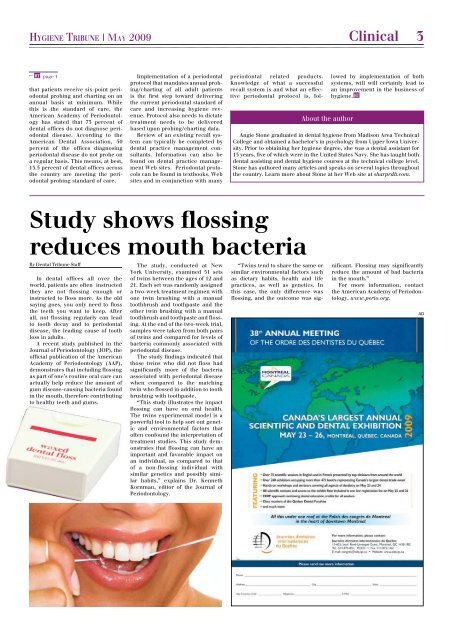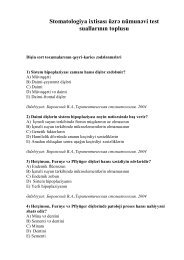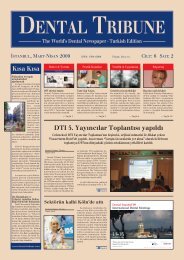DENTAL TRIBUNE
DENTAL TRIBUNE
DENTAL TRIBUNE
You also want an ePaper? Increase the reach of your titles
YUMPU automatically turns print PDFs into web optimized ePapers that Google loves.
HYGIENE <strong>TRIBUNE</strong> | MAY 2009 Clinical 3<br />
� HT page 1<br />
that patients receive six-point periodontal<br />
probing and charting on an<br />
annual basis at minimum. While<br />
this is the standard of care, the<br />
American Academy of Periodontology<br />
has stated that 73 percent of<br />
dental offices do not diagnose periodontal<br />
disease. According to the<br />
American Dental Association, 50<br />
percent of the offices diagnosing<br />
periodontal disease do not probe on<br />
a regular basis. This means, at best,<br />
13.5 percent of dental offices across<br />
the country are meeting the periodontal<br />
probing standard of care.<br />
Implementation of a periodontal<br />
protocol that mandates annual probing/charting<br />
of all adult patients<br />
is the first step toward delivering<br />
the current periodontal standard of<br />
care and increasing hygiene revenue.<br />
Protocol also needs to dictate<br />
treatment needs to be delivered<br />
based upon probing/charting data.<br />
Review of an existing recall system<br />
can typically be completed by<br />
dental practice management consultants.<br />
Information can also be<br />
found on dental practice management<br />
Web sites. Periodontal protocols<br />
can be found in textbooks, Web<br />
sites and in conjunction with many<br />
Study shows flossing<br />
reduces mouth bacteria<br />
By Dental Tribune Staff<br />
In dental offices all over the<br />
world, patients are often instructed<br />
they are not flossing enough or<br />
instructed to floss more. As the old<br />
saying goes, you only need to floss<br />
the teeth you want to keep. After<br />
all, not flossing regularly can lead<br />
to tooth decay and to periodontal<br />
disease, the leading cause of tooth<br />
loss in adults.<br />
A recent study published in the<br />
Journal of Periodontology (JOP), the<br />
official publication of the American<br />
Academy of Periodontology (AAP),<br />
demonstrates that including flossing<br />
as part of one’s routine oral care can<br />
actually help reduce the amount of<br />
gum disease-causing bacteria found<br />
in the mouth, therefore contributing<br />
to healthy teeth and gums.<br />
The study, conducted at New<br />
York University, examined 51 sets<br />
of twins between the ages of 12 and<br />
21. Each set was randomly assigned<br />
a two-week treatment regimen with<br />
one twin brushing with a manual<br />
toothbrush and toothpaste and the<br />
other twin brushing with a manual<br />
toothbrush and toothpaste and flossing.<br />
At the end of the two-week trial,<br />
samples were taken from both pairs<br />
of twins and compared for levels of<br />
bacteria commonly associated with<br />
periodontal disease.<br />
The study findings indicated that<br />
those twins who did not floss had<br />
significantly more of the bacteria<br />
associated with periodontal disease<br />
when compared to the matching<br />
twin who flossed in addition to tooth<br />
brushing with toothpaste.<br />
“This study illustrates the impact<br />
flossing can have on oral health.<br />
The twins experimental model is a<br />
powerful tool to help sort out genetic<br />
and environmental factors that<br />
often confound the interpretation of<br />
treatment studies. This study demonstrates<br />
that flossing can have an<br />
important and favorable impact on<br />
an individual, as compared to that<br />
of a non-flossing individual with<br />
similar genetics and possibly similar<br />
habits,” explains Dr. Kenneth<br />
Kornman, editor of the Journal of<br />
Periodontology.<br />
periodontal related products.<br />
Knowledge of what a successful<br />
recall system is and what an effective<br />
periodontal protocol is, fol-<br />
About the author<br />
Angie Stone graduated in dental hygiene from Madison Area Technical<br />
College and obtained a bachelor’s in psychology from Upper Iowa University.<br />
Prior to obtaining her hygiene degree, she was a dental assistant for<br />
15 years, five of which were in the United States Navy. She has taught both<br />
dental assisting and dental hygiene courses at the technical college level.<br />
Stone has authored many articles and speaks on several topics throughout<br />
the country. Learn more about Stone at her Web site at sharprdh.com.<br />
“Twins tend to share the same or<br />
similar environmental factors such<br />
as dietary habits, health and life<br />
practices, as well as genetics. In<br />
this case, the only difference was<br />
flossing, and the outcome was sig-<br />
lowed by implementation of both<br />
systems, will will certainly lead to<br />
an improvement in the business of<br />
hygiene. HT<br />
nificant. Flossing may significantly<br />
reduce the amount of bad bacteria<br />
in the mouth.”<br />
For more information, contact<br />
the American Academy of Periodontology,<br />
www.perio.org.<br />
AD




